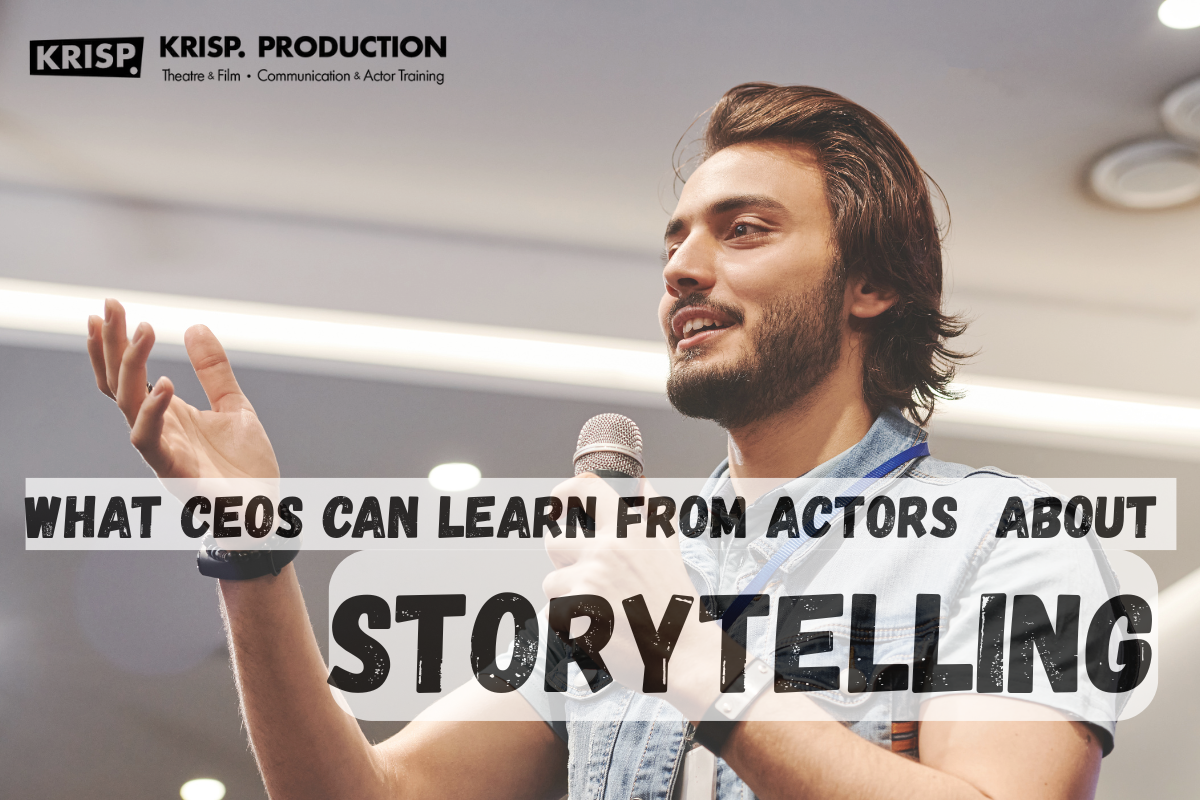General
What CEOs Can Learn from Actors About Storytelling

The best business leaders are a lot like actors: They know how to tell stories. Both professions require holding an audience’s attention and delivering messages that inspire action.
At Krisp Production, we help executives develop these narrative skills using proven acting techniques.
In this article, we’ll explore how CEOs can borrow a thing or two from the actor’s playbook. You’ll also learn about techniques on how to improve your storytelling, connect with stakeholders, and communicate your vision with greater impact.
Ready to change your executive presence? Let’s get started.
Adopt the Actor Mindset First for Executive Engagement
The first thing you can learn from actors is getting in the right mindset before a board meeting.
Before stepping into the spotlight, actors spend time backstage getting their heads right. They centre themselves, get clear on what they want to achieve, and mentally prepare for what’s coming.
You can do the same thing for your next board meeting or investor pitch. We assure you, everyone will notice the difference in your performance.
The techniques below will show you how to make this happen.
The Core of an Executive Engagement Programme
You can build your own preparation routine as an executive by simply trying to spend just five minutes before big meetings. It’ll help you get clear on your main message and goals.
Also, take a moment to imagine the outcome you want. Then ground yourself in your purpose and the value you bring to the room.
We know this advice works in practice because our team has found that leaders who prepare in advance can communicate with much better clarity and confidence when the stakes are high.
Building a Sense of Presence and Authenticity
Next up, you need to affirm your presence. But how? We recommend keeping your shoulders back and planting your feet firmly, so that you project confidence to everyone in the room. Plus, your body language tells its own story, so use controlled hand movements to emphasize your main points.
Besides, when you move around the room with a clear purpose, you show everyone that you own the space completely. Since you’re a leader, that’s what people least expect from you. Don’t disappoint them.
A Guide to Powerful Brand Storytelling
Think about the last commercial that stuck with you. The ad probably told a story about someone facing a problem and finding a solution through the product or service, right? This storytelling principle applies to your business communications as well.
And here’s what actors do about it: they understand that every great performance needs a clear story structure. Without this structure, even the best delivery falls flat and confuses the audience. We recommend that you also use this storytelling framework to make your brand messages more powerful.
The best part is that this approach works for everything, including team meetings and marketing campaigns.
But how exactly do you create stories and adjust them using the mentioned structure? That’s what we’ll talk about next.
How to Create a Compelling Brand Story
Every compelling brand story has three basic parts: a relatable main character, a challenge they face, and a way to solve the problem.
Let’s start with the main character. It should be someone your audience can relate to easily. This character might be a customer, a team member, or even your company as a whole.
And the challenge needs to feel real and important to your audience. But why? It’s because people connect with stories when they see themselves in the struggle or opportunity you describe. Because nobody cares about problems that aren’t theirs, you know!
Structuring Different Brand Stories
You can use this four-part framework to organize any brand story you want to tell. The structure works for internal updates, marketing campaigns, and investor presentations.
Here’s how to build your story step by step:
- The Hook: Your opening should feature a recognizable problem or situation that your audience faces daily. It must make people think, “That’s what happens to me!” For example, “Every morning, Sarah checks her phone and feels overwhelmed by 47 unread emails.”
- The Inciting Incident: Something specific needs to change everything in your story. Maybe Sarah realizes her current email system is costing her three hours of productivity each day. The incident should feel like a turning point that demands immediate action.
- The Rising Action: Walk your audience through the required concrete steps to address the challenge, and that the actions are realistic. Follow Sarah’s journey as she researches solutions, tests different approaches, and faces setbacks.
- The Resolution: A clear solution and new reality have to arise from the struggle. Also, the resolution should demonstrate measurable benefits and positive change. Returning to Sarah’s story, show how she manages her inbox in 20 minutes each morning and has time for strategic work.
Trust us, audiences always find this kind of structure engaging. Each part builds on the previous one to create a complete and satisfying narrative experience (our brain LOVES well-told stories).
Learn Narrative Delivery for a Brand
Actors spend years learning how to use tone, pace, and rhythm to guide audience emotions and attention. They spend this time because they understand that their voice is their primary instrument.
However, most executives focus on only content while ignoring such delivery techniques that make messages memorable and persuasive.
To improve yourself, you need to be an expert on vocal variety to control exactly how people feel about your message. Your audience will lean in during build-ups and feel energized when you pick up the pace.
The three vocal techniques here will improve your brand storytelling:
- Controlling the Pause: Strategic silence after an important statement creates powerful emphasis and gives your audience time to absorb important information. The pause builds anticipation and makes your next words carry more weight with listeners.
- Pace Changes Work Magic: When you speed up your speech around opportunities or successes, excitement builds naturally. So, slow down deliberately to signal that something important is coming and draw careful attention from your audience.
- Pitch Variation Adds Life: If you have a flat, monotone delivery, it’ll drain emotion and authority away from your messages. Rather, use higher pitches to convey enthusiasm, and use lower tones to suggest confidence and gravity in serious moments.
Improve Your Leadership Communication Today
Why do some CEOs mesmerize audiences while others struggle to hold attention? It comes down to storytelling skills. Without these qualities, even interested people will forget your presentation. Fortunately, proven acting techniques can solve this communication problem completely.
In this guide, we’ve explored the actor’s mindset for executive presence, brand storytelling frameworks, and vocal delivery techniques. We’ve also covered audience engagement strategies that create genuine emotional connections with any group.
Krisp Production‘s corporate workshops teach executives these exact storytelling skills through specialized acting methodologies. Contact us to improve your leadership communication and inspire action from any audience today.















